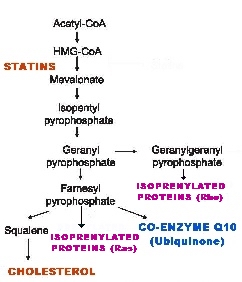The truth about statins
Part 2: Statins also inhibit the production of other important compounds
Statins don't just inhibit the production of cholesterol. Refer again to the simplified diagram of cholesterol production — this time with other compounds included which are formed by the same pathway as cholesterol.
You will see that we also have Co-Enzyme Q-10 (CoQ10) and two types of Isoprenylated Proteins.
Coenzyme Q-10
Coenzyme Q-10, also known as ubiquinone, or CoQ10, is a vitamin-like substance. It is, by nature, present in all human cells and is responsible for the production of the body's own energy. In each human cell food energy is converted into energy for our body in the mitochondria with the aid of CoQ10.
 Ninety-five percent of all our body's energy requirements is converted with the aid of CoQ10.[1,2] So you won't be surprised to learn that those organs with the highest energy requirements have the highest CoQ10 concentrations. These include the heart, the lungs and the liver.[3-5]CoQ10 is also the only fat-soluble antioxidant our bodies synthesize; it protects heart against functional impairment induced by stress; it helps the aging heart tissue to tolerate stress; it strongly inhibits LDL oxidation under all conditions, and it significantly reduces atherosclerosis.
Ninety-five percent of all our body's energy requirements is converted with the aid of CoQ10.[1,2] So you won't be surprised to learn that those organs with the highest energy requirements have the highest CoQ10 concentrations. These include the heart, the lungs and the liver.[3-5]CoQ10 is also the only fat-soluble antioxidant our bodies synthesize; it protects heart against functional impairment induced by stress; it helps the aging heart tissue to tolerate stress; it strongly inhibits LDL oxidation under all conditions, and it significantly reduces atherosclerosis.
CoQ10 is also highly effective in protecting skin cells from UV damage; it energizes the heart and brain, exerts neuroprotective effects, slows functional decline in Parkinson's Disease and other mitochondrial disorders and neurodegenerative diseases, and it slows the aging process.
It is important to know that CoQ10 decreases with age. So the last thing you want is any medication that lowers CoQ10 still further.
Yet as you can see, by inhibiting the production of the enzyme, HMG Co-A reductase, statins not only reduce cholesterol production, they also reduce the production of CoQ10.
Isoprenylated Proteins
And that isn't all. You will note that two types of isoprenylated proteins are also made by this pathway. These also play an important role in our bodies. I will quote from a 2005 study:
"This same biosynthetic pathway (mevalonate production) leads to the prenylation, or activation, of regulatory proteins such as guanosine triphosphate (GTP)-binding proteins. "These GTP-binding proteins are important in cell health and control of apoptosis, or cell death. "If statins inhibit the activation of these regulatory proteins, uncontrolled cell death may occur.[6]"
As will be seen in Part 3, these two unwanted effects of statins are potentially very harmful to our health — and the probable reason for a wide range of adverse side effects.
References
1. Ernster L, Dallner G. Biochemical, physiological and medical aspects of ubiquinone function. Biochim Biophys Acta 1995; 1271: 195-2042. Dutton PL, Ohnishi T, Darrouzet E, et al. Coenzyme Q oxidation reduction reactions in mitochondrial electron transport. in Coenzyme Q: Molecular mechanisms in health and disease edited by Kagan VE and Quinn PJ, CRC Press, Boca Raton, 2000, pp 65-82
3. Okamoto T, Matsuya T, Fukunaga Y, et al. Human serum ubiquinol-10 levels and relationship to serum lipids. Int.JVit Nutr Res 1989; 59: 288-292.
4. Aberg F, Appelkvist EL, Dallner G, Ernster L. Distribution and redox state of ubiquinones in rat and human tissues.. Arch Biochem Biophysics 1992; 295: 230-234
5. Shindo Y, Witt E, Han D, et al. Enzymic and non-enzymic antioxidants in epidermis and dermis of human skin, Invest Dermatol 1994; 102: 122-124.
6. Tomlinson SS, Mangione KK. Potential adverse effects of statins on muscle. Phys Ther 2005; 85: 459-465.
Part 4: Statins, women and the elderly | Part 5: Statins or sunshine? | Part 6: Conclusion